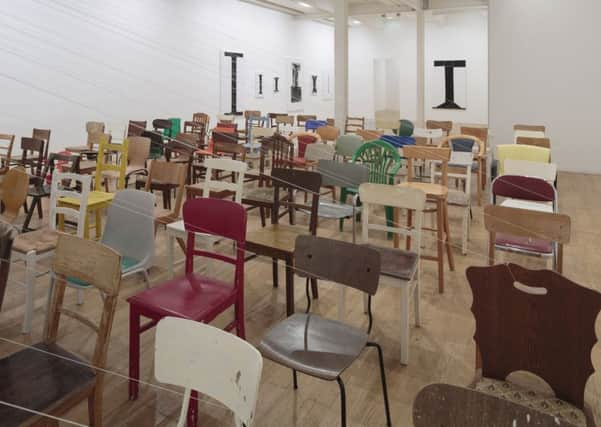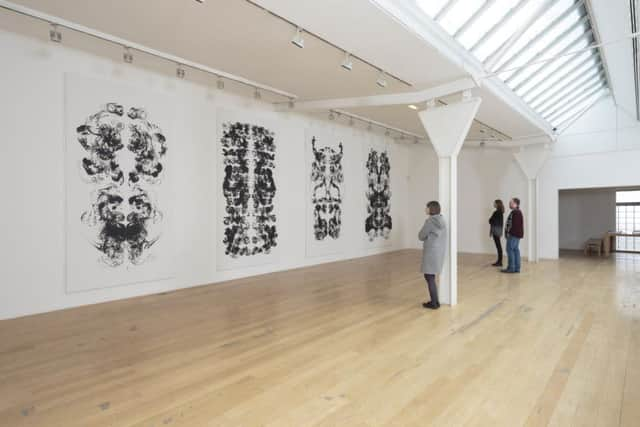Visual art: Mark Wallinger: Mark, Fruit Market, Edinburgh and DCA, Dundee


Mark Wallinger: Mark
Fruitmarket Edinburgh and DCA, Dundee
***


Mark Wallinger: The End
Ingleby Gallery, Edinburgh
***
Last year, Mark Wallinger unveiled a body of work unlike anything he had done before. Seventeen of his 66 ‘id’paintings were hung on a monumental scale in one of Hauser & Wirth’s two Savile Row spaces, each of them twice Wallinger’s height and the width of his arm-span, painted using his hands in black acrylic paint. Like giant Rorschach tests, abstract but symmetrical, they hung there like a Freudian drama played out on an epic scale.


A selection of these paintings form the core of the touring exhibition that now occupies both the Fruitmarket in Edinburgh and DCA in Dundee, with other works from his recent oeuvre chosen to complement them. It’s his first major show in Scotland and arrives with considerable fanfare, occupying two of our major contemporary art spaces for three months. The scale alone is making a bold claim about the artist’s significance.
Advertisement
Hide AdAdvertisement
Hide AdThere are four id paintings at the Fruitmarket, but, imposing as they unquestionably are, they are somewhat diminished in their impact when not shown as part of a larger group. One starts to examine them forensically: are they a manifestation of some aspect of the artist’s mind? Then, in an appropriately Freudian way, one starts to examine oneself: the penchant for finding images; the way the abstract-but-symmetrical idea messes with the head.
At DCA, it’s a different story. Here, 12 id paintings encircle a room with Self (Symbol), a human-size sculpture of a typographical “I”, in the centre. It feels like a kind of Freudian temple to the self. The longer you spend with them, the more you forget all you know about how they were made, they stop looking like works produced on a human scale and become both larger and stranger. You might be an explorer on another planet wondering who – or what – is worshipped in such a place.
However, the id paintings raise a question about scale which is pertinent to some of Wallinger’s other work. Is there a correlation between the size of a large work and its significance? When Wallinger recreated Brian Haw’s anti-war protest to occupy the Tate’s Duveen Gallery (for which he won the 2007 Turner Prize) the work seemed so urgent and timely that the size felt about right. Do the id paintings take some of their power from their monumental scale? Do they need to justify it?
I had a similar question watching Sleeper (2004), at the Fruitmarket, last seen in the UK in the Turner Prize show ten years ago. It shows Wallinger, dressed in a bear costume, wandering about at night in the glass atrium of Berlin’s Neue Nationalgalerie. There is a subtext to do with surveillance, spies, captive animals, and an East German television series which traumatised Wallinger as a boy, but I suspect, if this was five minutes long, it might feel less significant than it does. At two and half hours long, it makes a claim for itself, but does it have something to say which is worth two and a half hours of saying it?
Construction Site (at DCA), is a 83-minute film made by Wallinger at Folkstone for the Triennial, in which a crew of three men build a scaffolding platform on the shingle beach reaching precisely to the height of the horizon and then take the whole thing down again. It’s rather mesmerising to watch – they are clearly very good at what they do – but is it a manifestation of something profound or a piece of monumental pointlessness?
Other works have greater resonance, and seem to open up a realm of ideas which feels more productive. According to Mark (Fruitmarket) is an installation of 100 chairs, all different, each with the name “Mark” scrawled on the back, all facing a point on a wall to which they are linked by a piece of string. They quickly become a silent audience, a congregation hanging on a speaker’s words, but is there a message to listen to? And who gives that message? Is it the artist, or is he sitting here wondering with the rest of us?
Orrery (DCA) has a similar profundity. Named after a mechanical model of the solar system, it’s a four-screen film installation shown in the round which the artist has made by driving round a roundabout near his childhood home in Essex. At the centre of the roundabout is an oak tree planted to commemorate the legendary Fairlop Oak which stood near the site. Each screen shows the same journey, but in a different season. After a short time, it starts to feel as if everything is rotating, the viewer included. It’s rich with allusions to the past, the planets, the seasons, even post-Brexit Britain, trapped in its own limited orbit.
Advertisement
Hide AdAdvertisement
Hide AdWallinger, a bit like Douglas Gordon, is a master of the concept, of coming up with an idea so simple you wonder why you didn’t think of it first: why not photograph my hands with my iPhone in the same position as the hands of God and Adam on the Sistine Chapel ceiling? Why not create a model of the Tardis and cover it with mirrors? Why not take Hitchcock’s Psycho and slow it down until it lasts for 24 hours?
The trouble, sometimes, with an ingeniusly simple concept is that the work itself has a near disposable quality: you see it, you get the idea, you move on. Perhaps the better the artist does his job (and Wallinger does it very well) the easier it becomes to get the idea and go.
This is a much-anticipated exhibition, ambitious and carefully put together. The danger is that many of these works deliver their idea, question and punchline without proposing any more profound or lasting engagement with the viewer.
There is something of the same monumental scale in Wallinger’s The End, on show at the Ingleby Gallery. With what feels like appropriate irony, they have chosen it as the beginning of their year-long project “and per se and”, a sort of artistic relay: after two weeks, it will be joined by another work; then, two weeks later, it will be replaced and the second work will stay on, and so on.
The End is an 11-minute 35mm film in which the names of all the characters in the Bible, from Adam to Jesus, scroll past like the closing credits of an old film to the strains of Strauss’ Blue Danube. The whirr of the projector and the crackly screen create – in this digital age – the sense of an old epic, a museum-piece narrative dusted off, though we arrive only just in time to catch it finishing. It’s another marathon undertaking but is weirdly compelling as one spots familiar names, and particularly strange ones. It’s long enough to feel long, not so long we lose interest. In this respect, it knows exactly how long it should be.
Mark Wallinger: Mark until 4 June; Mark Wallinger: The End until 1 April